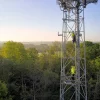Gov Consults on Fees for New Digital UK Map of Underground Cables

The Government has today opened a new consultation on the sharing of information and fees payable by street works firms as part of operating the new National Underground Asset Register (NUAR), which is a digital map of underground UK pipes and cables (broadband, water etc.) that is partly designed to help reduce accidental damage.
The government currently sees huge potential for such maps to help improve the way that national infrastructure is planned, built and managed (e.g. future full fibre broadband and 5G mobile networks). The map could also cut the amount of accidental damage that occurs to existing infrastructure (one estimate suggested this costs up to £2.4bn each year) and boost economic growth by “at least £400m” per year due to increased efficiency, fewer asset strikes and reduced disruptions.
The NUAR – originally developed alongside Ordnance Survey (OS) and Atkins – is the solution they came up with, which is in the process of going through somewhat of a final public beta phase before full introduction. The service, once “fully operational by the end of 2025“, will pull together information from 600 underground asset owners, covering 3 million kilometres of buried pipes and cables.
Advertisement
As part of that the government are today launching a new consultation that covers the sharing of information with NUAR and the access to this information by those carrying out street works. It also provides some “initial thinking” on the fees payable by street works undertakers for the operation of the NUAR service.
Baroness Jones, UK Technology Minister, said:
“The National Underground Asset Register is a gamechanger for the entire economy, because all of us depend in one way or another on infrastructure that’s underground. We waste time and money dealing with the disruption caused when pipes and cables are damaged, and the Register will help people work smarter, so more of those accidents can be avoided.
For this to all work, it is critical that the information in NUAR is kept accurate and up-to-date. We want to work with industry and asset owners to ensure that happens – and listening to them, through this consultation, is an important step on the road forwards.”
The collection of these fees will not generate a profit for Government, and it is envisaged that no charges will be imposed before there is comprehensive information in the platform. A subsequent consultation will be carried out before this fees structure is introduced, and on current timelines, such fees are apparently “unlikely” to be introduced before 2028.
The UK Internet Service Providers Association (ISPA) has previously warned the government against putting the NUAR on a statutory footing before it’s truly “fit for purpose, proportionate and can fully deliver on expectations“.
Mark is a professional technology writer, IT consultant and computer engineer from Dorset (England), he also founded ISPreview in 1999 and enjoys analysing the latest telecoms and broadband developments. Find me on X (Twitter), Mastodon, Facebook, BlueSky, Threads.net and Linkedin.
« Virgin Media O2 Expand UK 3G Mobile Switch Off to Watford





















































As long as the fees are just to cover the cost of running the platform & don’t just turn into another stealth tax…..
Amen to that.
Here the local toytown councillors are proposing higher fees for streetworks and lane rental as a way to reduce roadworks and increase revenue with a strong onous on the latter. There is much cheering from those wedded to the private motorcar but nobody seems to realise that these costs won’t be paid from the much grumbled about “huge profits” (often less than £1 per household per month) and will just be added to service costs…. on top of the council tax that has doubled in the last 12years and gone from 78% to 110% of a months take-home pay.
A big issue here in my old industrial northern town is not so much strikes on other utilities but hitting unknown, unmapped infrastructure.
Recently we had temporary lights on a busy A road after the gas companies contractors went through an unmapped culvert. There then followed many months of legal wrangling as the gas co complained the council didn’t tell them it was there and that they shouldn’t pay because the electricity company had already breached and damaged it at some point in the past by laying a cable through it. So basically there was a big argument over who should pay, while the lane was closed and the pile of excavated spoil grew grass to the point it was strimmed.
It is a story that has been repeated several times and a new saga has now started after a new sink hole was found to be caused by another collapsed unknown unmapped culvert. The council have found gas pipes and cables bisecting through the culvert causing a blockage which has then caused the water to wash away the structure. Temp lights have been errected, lanes closed, mayhem caused, hiviz jackets have looked into the hole, it’s been agreed the cables and pipes need removing, but no work done because nobody wants to pay.
I thought we already had a system (DigDAT) that supplied this information and maps to contractors and other Public Utilities?